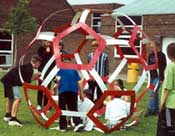The Truncated Icosahedron
Steps to Drawing a Football
We can bring all that we have learnt together to help draw the football. Perhaps the simplest steps are shown in the pictures:
 |
1) First draw a regular pentagon. |
|
2) Add lines away from each corner of the pentagon. |
|
|
3) Add groups of three lines to form 5 hexagons surrounding the pentagon. |
|
|
4) Add more groups of three lines to make up 5 more pentagons on the outside (these pentagons are very distorted because they are curving away). So now we have 6 pentagons in total, half the total to be found going around the ball. As we can’t see through the ball these are all the pentagons you need to draw. |
|
|
5) Add curved lines (or groups of three lines if you prefer) to form the final (very distorted) hexagons on the outer edge of the ball. This completes the front side of the football as shown in the pictures. |
|
|
6) Finally shade in the pentagons to make it look more like a football. Do not be scared to draw the lines in fast but make sure that each line is done confidently. This way the football will look like it is 'real'. |
C60 - BuckminsterfullereneIn 1985 a new form of carbon was discovered having the same shape as a tiny football. An atom is to be found at each corner of the structure so it has 60 atoms. As C is the symbol for carbon it was called C60. The Molecule was named after the famous architect Richard Buckminster Fuller who designed large round dome buildings rather like half a football. The molecule was therefore called C60, or Buckminsterfullerene. This new discovery is very exciting and is opening up new fields of science. Structures made of these carbon network of atoms are very light and extremely strong. In 1996 the Nobel Prize for Chemistry was awarded to the scientist discovers (Harry Kroto, Rick Smalley and Bob Curl) for this amazing work. What we have learned here about the structure and symmetry of a football was crucial to the discovery of C60, because without it the scientists would not have actually understood the significance of what they had discovered!
A large sculpture of C60, Buckminsterfullerene made by the pupils at the Angmering School (West Sussex). |
Second Drawing
From what you have learnt about the structure of a football it should now be a lot easier to draw a football. Now make a drawing and compare it to the one you made at the start.
Summary
.gif) We have chosen to study a football in this article but what we have learnt could be applied to all sorts of symmetrical objects that we might want to draw. To improve our drawing skills we just need to remember to try and observe (really observe) what is in front of us – i.e. to see clearly the shapes, patterns and symmetries.
We have chosen to study a football in this article but what we have learnt could be applied to all sorts of symmetrical objects that we might want to draw. To improve our drawing skills we just need to remember to try and observe (really observe) what is in front of us – i.e. to see clearly the shapes, patterns and symmetries.
Questions
.gif) 1. How many corners are there in the icosahedron and how many pentagons in a football?
1. How many corners are there in the icosahedron and how many pentagons in a football?
2. Look back at the three pictures of footballs. Now you know more about the structure of a football can you see what was wrong with the images?
Acknowledgements
For inspiration and support I would like to thank Prof. Harry Kroto, the late Jan Meering (Angmering School), NESTA (The National Endowment for Science, Technology and the Arts) and the Campaign For Drawing (NESTA funded).
This content has been re-published with permission from SEED. Copyright © 2025 Schlumberger Excellence in Education Development (SEED), Inc.


